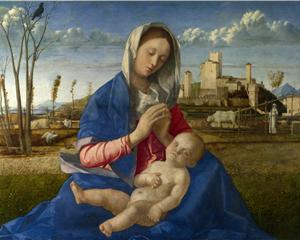Impression, Sunrise (Impression,soleil levant) by Claude Monet 1872
Depicted in the harbor of Le Havre in France, this painting launched the Impressionist era. The word impression originally derived from the harsh review of a critic writing for the Le Charivari newspaper taken from Monet’s title work Impression, Sunrise the critic inadvertently coined the new term.
Below is an excerpt of Claude Monet’s explanation of how he came to name the above works and the critics response to this new style of painting.
“Landscape is nothing but an impression, and an instantaneous one, hence this label that was given us, by the way because of me. I had sent a thing done in Le Havre, from my window, sun in the mist and a few masts of boats sticking up in the foreground. … They asked me for a title for the catalogue, it couldn’t really be taken for a view of Le Havre, and I said: ‘Put Impression.’ [1]
It was first displayed in 1874[2] during the first independent art show of the Impressionists (who were not yet known by that name). Critic Louis Leroy, inspired by the painting’s name, titled his hostile review of the show in Le Charivari newspaper, “The Exhibition of the Impressionists”, thus inadvertently naming the new art movement. He wrote:
Impression—I was certain of it. I was just telling myself that, since I was impressed, there had to be some impression in it … and what freedom, what ease of workmanship! Wallpaper in its embryonic state is more finished than that seascape.” http://en.wikipedia.org/wiki/Impression,_Sunrise
When I read the critics words it truly made me cringe for Claude Monet who lived this pivoting moment in the Impressionist movement. I wonder what Monet was thinking, what was he feeling…when he first learned of this review. Regardless, it is Claude Monet’s name that is widely recognized from the Impressionist era and what was that critic guy’s name again?
Please note the following artists and their works.
Impressionist artist Frederick Childe Hassam 1869-1935
San Pietro, Venice Completion Date: 1883 Genre: Cityscape
I selected some of Frederick Childe Hassam works because his name was unknown to me, unlike Claude Monet’s or other well-known Impressionists and their works. Notice the San Pietro, Venice painting with its asymmetrical shapes of the tall buildings with the horizontal lines in the land, water and sky.
His shift towards Impressionist paint began through the 1890’s, he became known as an “extreme Impressionist” himself. He was also known for his “flag and window series” should you want to learn more about his art pieces be sure to access the link I provided below.
As art appreciation, concerning the Impressionists style I tend to have some negative feelings about the Impressionist subject matter. I can appreciate the prismatic colors, the landscapes, the broken brush strokes and use of impasto, the illumination of light and the use of creating shadows by using color instead of neutral, black or grays. For myself, I feel the Impressionist’s style is painted as an observer, watching a crowd, an activity or particular person(s) from a distance; feels distant, and a bit boring, captured in a fleeting and airy moment. Despite my personal opinion, I can still remember Claude Monet’s name…and what was that newspaper guy’s name?
Below are two High Renaissance paintings for comparison. Painted in the pyramid composition style which focused on the main image depicted in the center and was often flanked on either side with parallel weighted forms.
Renaissance painter, Giovanni Bellini
Madonna of the Meadow (Madonna del Prato)
Completion Date: 1505, Style: High Renaissance Genre: religious painting
From the top of Madonna’s head begins the point to form the pyramid and her left and right sides are slightly downward creating angled lines , the cropped bottom line is defined cross wards forming the complete pyramid.
Another example of Giovanni Bellini works is shown below in the Renaissance pyramid format notice the similar weights that flank the image, unlike the Impressionist’s asymmetrical style.
Sacred Conversation Style: High Renaissance Genre: religious painting
Impressionist painters commonly used casual everyday life events captured in a moment as if a photographer snapped a photo of the image. Not only were these painters known for asymmetrical designs they also used high horizontal lines and plunging perspectives as well.
Below are two other examples of the Impressionist’s use of high horizontal line composition and plunging perspective.
Duck lsland By artist Frederick Childe Hassam
Completion Date: 1906, Style: Impressionism, Genre: marina
Note the horizontal line in the distance and the compositional balance of the asymmetrical rocks on the parallel sides of this painting.
The Holly Farm By artist Frederick Childe Hassam
Completion Date: 1902, Style: Impressionism, Genre: landscape
Notice the high horizontal lines of the roofline, the plunging perspective of the courtyard and balanced asymmetrical trees on the opposites sides of the painting.
A Back Road By artist Frederick Childe Hassam
Style: Impressionism, Genre: landscape 1884
This last piece ties so many of the elements of an Impressionist painter’s style. For example in the distance there’s the tree line on top the hill,(high horizontal line) meeting in the middle is the (perspective plunge) in the dirt road and parallel within the painting is the (asymmetrical) trees and the ruts in the road.
Oh, by the way what was that newspaper critic’s name again? Claude Monet no that was the Impressionist ….
http://en.wikipedia.org/wiki/Impression,_Sunrise
http://www.paintingmania.com/back-road-162_12963.html
http://www.wikipaintings.org/en/childe-hassam/san-pietro-venice
http://www.wikipaintings.org/en/giovanni-bellini/madonna-and-child-1490-1
http://www.florencegriswoldmuseum.org/learning/foxchase/html/about_impressionism.php







